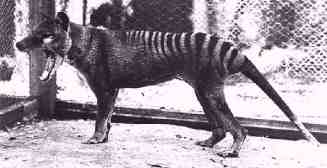
The
CryptoWeb:
An Online Encyclopedia of Cryptozoology

The tasmanian tiger or thylacine
(Thylacinus cynocephalus), one of the "mascots" of cryptozoology.
Although officially extinct since 1937, reports of this animal still surface in Australia.
Cryptozoology: The study of unknown or
undiscovered animals.
Cryptozoology is generally a discredited sort of pseudoscience, based on the assumption
it's primarily concerned with Bigfoot and the Loch Ness Monster.� As a result, it's
usually (unfortunately) found in bookstores next to volumes on astrology, UFOs, and other
fringe sciences.
The first cryptozoological renaissance took place in the late 1940s, with Ivan T. Sanderson's articles on various topics within what is now considered cryptozoology (yeti, mokele-mbembe, etc.).� It was these articles which prompted a Belgian zoologist named Bernard Heuvelmans (the "father of cryptozoology") to conduct his own research into these animals which existed in reality's gray area.� In 1955, he released On the Track of Unknown Animals, and the science of cryptozoology was born.
The second renaissance took place in the mid to late 1970s. � Topics such as psychic phenomena, ghosts, and alternative religions gained widespread popularity, and cryptozoology took part in this upsurge of interest.� In the minds of many, cryptozoology became intertwined with the paranormal, and became one of the so-called "New Age" topics.� This led to several out-there theories, including the infamous "Bigfoot is an alien" theory.� However, the 1970s renaissance had a second effect--the era spawned many other, more serious, cryptozoological researchers.
Cryptozoology today is in a transitional phase--still technically considered a fringe science, it is gaining more and more respectability as the track record of newly-discovered animals previously known from the cryptozoological literature has grown.� More and more cryptozoologists are taking a practical approach to their science.
Now, as we stand in the early days of a new millennium, cryptozoology could be awaiting a third renaissance.� If even one of the major cryptids (cryptozoological animals) were discovered, the science could leap over into the mainstream and become a full part of� "normal" zoology.
These pages tell the stories of some of the cryptids that could be awaiting discovery.
Global
Indices of Cryptozoology
Cryptozoology In-Depth
Other Site Features
A Cryptozoology Gallery
Inside are dozens of pieces of artwork and photographs concerning all facets of
cryptozoology, from hairy hominids to lake monsters and Chupacabras.� These photos were
collected from various sites around the web, and hopefully no copyrights will be violated;
credit is given where known copyrights apply.� �
Personalities in Cryptozoology
Brief profiles of some of the most notable researchers in the field, from old timers
such as A.C. Oudemans to contemporaries such as Loren Coleman, and everyone in between.
Got a cryptid story you want to share with me?� Have any suggestions on how to make this site better, or cryptids that should be included?� Drop me a line!
All articles are � 1996-2001 Andrew D. Gable.